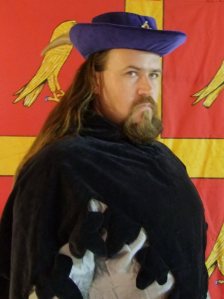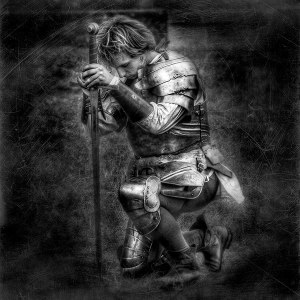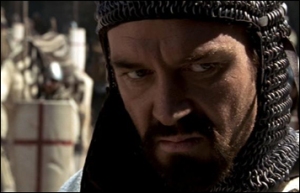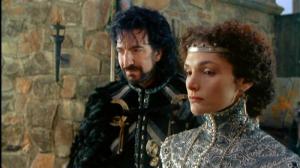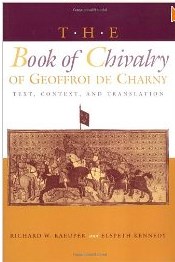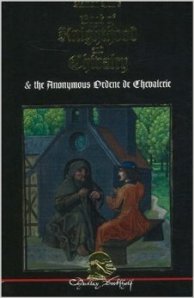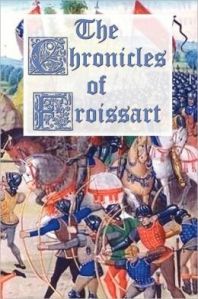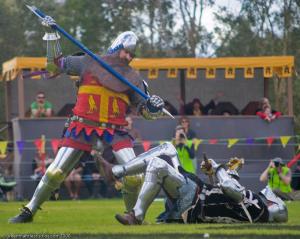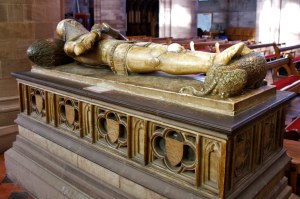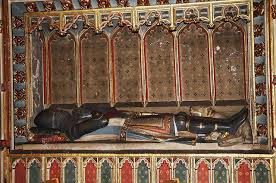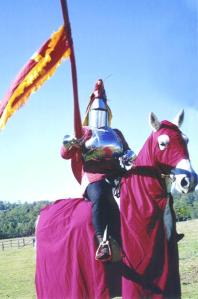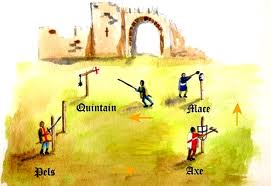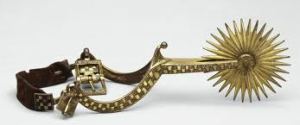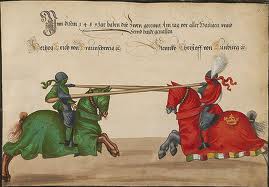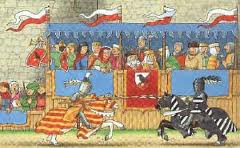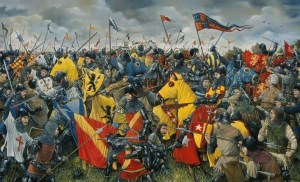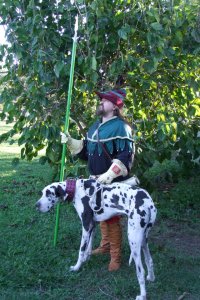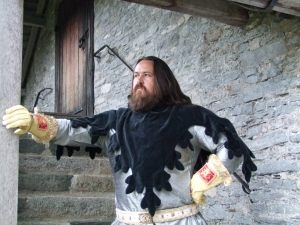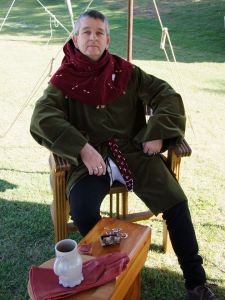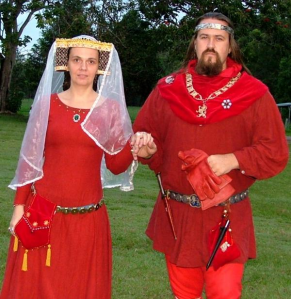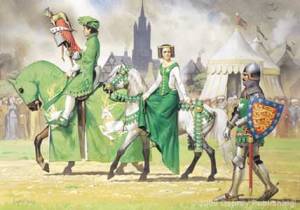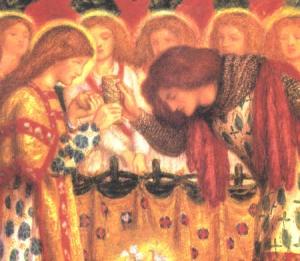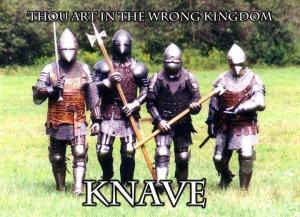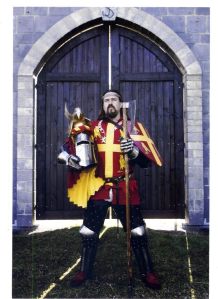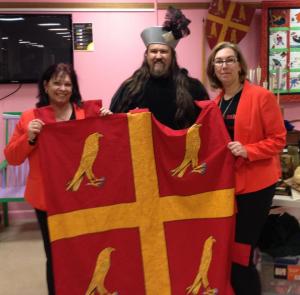This month I wished to look beneath the suit of armour and find out what truly made a medieval knight. And who better to ask than our good friend, Sir Justyn. Sir Justyn is a re-enactor with his group Eslite d’Corps.
So, Sir Justyn, how would you describe a true knight?
Modern perceptions of the medieval knight range from the stereotypical knight in shining armour, performing great deeds of chivalry for his lady,
to the black knight; a dark hearted villain, oppressor of the common man and pompous, arrogant, lover of violence.
Truth is the medieval knight was as hard to categorise. They had diverse motivations, personalities and traits, some of which had included the paragons of chivalry and villainy as mentioned above, but also included such traits as negotiator and diplomat, shrewd tactician, politician, merchant, traveller, courtier, poet and lover – the list could go on and on.
Occupations, duties, motivations and personalities aside, the majority of medieval knights were orthodox individuals and as a result we can profile the ‘average’ knight to a certain degree with confidence. Works such as Geoffroi de Charny’s Book of Chivalry, Ramon Lull’s book of chivalry, surviving chronicles by Froissart and the Chandos Herald, the Canterbury Tales, Le Morte ‘d Arthur, the Song of Roland and even the famous German fectbutchs or “fight books”, offer us glimpses into what kind of man the medieval knight would have been like during war, tournament and during times of peace.
How was a knight trained?
The potential knight was trained, or groomed, if you will, from a very young age to accept martial activities as the norm. This, of course, went hand in hand with the more ‘courtly’ training of etiquette, social activities such as dancing, singing and music, geography, nature, linguistics and culture, just to name a few.
Other pastimes such as chess not only served as a social engagement but as an exercise in strategy and tactics. His martial training would have consisted of, but by no means limited to, hunting, hastiludes or ‘lance games,’ training in swordsmanship with an array of weapons and tactics and wrestling or grappling, even though unarmed combat or ‘the laying on of hands’ was considered ‘ungentlemanly.’
And all this training kept them fit?
Yes, with all of this physical activity it is easy to perceive that the average knight was in very good health and peak physical condition, much akin to a modern athlete. Effigies, brasses and medieval contemporary art also allude to the fact that the medieval knight was a lean, mean, fighting machine.
There were of course exceptions. Geffroi de Charny, in his 14th century book of chivalry for example, laments how some of his fellow knights would seek to girdle themselves for reasons of vanity, instead of displaying the ‘bellies that God has given them.’ He goes on to say how some of these ‘girdles’ would be on so tight that they would impede the wearer to the point of exhaustion and lack of breath. Exceptions aside, being fit was more common than not.
Also of great importance to a knight was his horse or horses.
Sir Justyn
So important was this element that a man could never be a knight without having equestrian skills and his own horse or horses or the means to obtain a suitable warhorse if ever -heaven forbid- he should find himself without one.
His horsemanship skills would have been developed from a very early age and he was expected to be a competent if not expert rider by the time he became a squire in his early teens.
By this age he would have no doubt likely been introduced to falling from a mount at dangerous speeds during training or hunting. In actual fact many squires died during these pursuits and never became knights or fully-grown men for that matter.
One of the important symbols of the knight was his spurs.
If ever he should lose his title of knight, which would come about if he committed some great dishonour, his spurs would be hacked off with a blow of the sword. The symbology of this act represented the fact that without spurs a knight could not ride and not being able to ride meant not being a knight. Spurs were also symbolic in many formal occasions where a knight needed to display his rank and were worn during such events as well.
By the time he reached his adult age around 15 or 16, he would be participating in war and tournament.
Tournaments would have taught him about logistics of battle and the associated duties for a knight and his retinue on the move. It would usually serve as his induction to real war.
He was expected to be largely independent by this time though he would still be under the watchful eye of his older peers who played a part in his upbringing and training.
So would it have been like to be a knight?
He would be a very prominent figure in the eyes of those beneath him and a peer among his fellow knights.
He would have little time for fear of injury, hardship or death itself. Discomfort would be a necessity of life and so we could also imagine that he may not bemoan injury, hardship or death. This would paint a picture of a stoical man at arms or perhaps a carefree bachelor knight. His religious beliefs would also add to his demeanour. There was no life without religion in the Middle Ages and Christianity was accepted and unquestioned throughout feudal society. Religion was so important that entire armies would delay battles or cease hostilities during siege and battle to observe important dates on the Holy calendar.
Excommunication was a dire threat to the knight and he feared being denied entry to heaven more than death itself.
When not taking part wars, hunting, tournament or training the knight would take time to see to his personal household, assets and businesses and during his free time associate with other aristocrats both higher and lower in societal rank and display his skills of peace.
Activities would include riding around his domain or his lord’s domain, learning the lay of the land in the process, attending church services, entertainment such as banquets, dance, singing, music, reciting poetry or listening to recitals, visiting friends and family and if he had the money to spare, visiting merchants, the armourer, stables and such purchasing new things.
Sir Justyn checking his estate Sir Justyn’s friend, the Baron
Sir Justyn and his lovely lady.
What is the ‘code of chivalry’?
The code of chivalry was an ideal that the knight or squire would attempt to live up to. It governed his actions when he was level-headed though he may lapse under times of duress, when losing his temper or when he became passionate about something or someone.
Weaknesses of character may also cause him to act outside of the boundaries of chivalry, though he might have peers close to him to remind him or set the example for him to follow and thus displaying the knightly virtue of Franchise.
Chivalry served as a guide to correct conduct in the company of peers, in the courts, on the battle or tourney field and occasionally to the common folk as well. Each knight strove to live up to these ideals as often as he could and though more often than not he fell short, it played a major deciding factor in his actions and demeanour.
The Final Profile
The medieval knight was a skilled horseman and he always had a horse close at hand. He was certainly very fit, hardy and able. His skills as a combatant, combined with his equestrian ability made him a formidable force , especially when banded with his fellow knights.
His talents at taking lives on the field of battle made him feared and gave courage and heart to the men who fought on his side. He was a man of firm belief in his faith, authority and position. He was fearless Although he had a strong sense of justice and fair play, he also welcomed and relished the challenge of overwhelming odds and the chance to gain honour by fighting those who were famed as great knights. He was proud and passionate, humble and tempered. He was kind and loving to those close to his heart and relentless and fierce to his enemies. He was concerned with prestige and rank and thus concerned with income and wealth. Without these things he could not be a successful knight.
He was a noble made for war and was thusly concerned for all things warlike and noble.
Lions and Lilies would like to thank Sir Justyn for sharing his thoughts with us on the profile of a medieval knight. For more information on ‘Sir Justyn’ please visit his website at http://www.sirjustyn.com
Sir Justyn with the ladies from Lions and Lilies
(From Left: Cathy T, Sir Justyn, Cathy A)
By Cathy T

